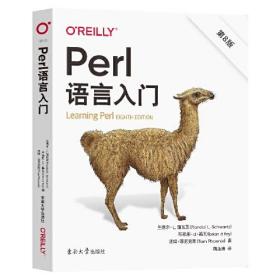
Perl语言入门
全新正版 极速发货
¥ 37.19 4.5折 ¥ 82 全新
库存6件
广东广州
认证卖家担保交易快速发货售后保障
作者(美)兰德尔·L·施瓦茨(Randal L.Schwartz),(美)布赖恩·d·福瓦(Brian d Foy),(美)汤姆·菲尼克斯(Tom Phoenix) 著
出版社东南大学出版社
ISBN9787564173722
出版时间2017-10
装帧平装
开本16开
定价82元
货号1201587431
上书时间2024-08-10
- 最新上架
商品详情
- 品相描述:全新
- 商品描述
-
作者简介
兰德尔·L·施瓦茨(Randal L.Schwartz),精通于软件设计、系统管理、安全、技术写作和培训,他是数本Perl语言方面“推荐阅读”书籍的合著者之一,包括《Learning Perl》《Programming Perl》和《Mastering Perl》(O’Reilly出版)。
布赖恩·d·福瓦(brian d foy),是一位多产的Perl培训师和作家,运营ThePerlReview以帮助人们使用和理解Perl。他是《Learning Perl》《Programming Perl》《Mastering Perl》(O’Reilly出版)和《EffectivePerlProgramming》(Addison—Wesley出版)的合著者之一。
汤姆·菲尼克斯(Tom Phoenix),在Stonehenge咨询服务公司教授Perl课程,并且在comp.lang.perl.misc和comp.lang.perl.moderated新闻组上回答问题。他是《Intermediate Perl》(O’Reilly出版)的合著者之一,也是一位Perl语言的贡献者。
目录
Preface
1.mtroduaion
Questions and Answers
Is This the Right Book for You?
What About the Exercises and Their Answers?
What Iflm a Perl Course Instructor?
What Does "Perl" Stand For?
Why Did Larry Create Perl?
Why Didnt Larry Just Use Some Other Language?
Is Perl Easy or Hard?
How Did Perl Get to Be So Popular?
Whats Happening with Perl Now?
Whats Perl Really Good For?
What Is Perl Not Good For?
How Can I Get Perl?
What Is CPAN?
Is There Any Kind of Support?
What Ifl Find a Bug in Perl?
How Do I Make a Perl Program?
A Simple Program
Whats Inside That Program?
How Do I Compile My Perl Program?
A Whirlwind Tour of Perl
Exercises
2.Scalar Data
Numbers
All Numbers Have the Same Format Internally
Integer Literals
Nondecimal Integer Literals
Floating—Point Literals
Numeric Operators
Strings
Single—Quoted String Literals
Double—Quoted String Literals
String Operators
Automatic Conversion Between Numbers and Strings
Perls Built—In Warnings
Interpreting Nondecimal Numerals
Scalar Variables
Choosing Good Variable Names
Scalar Assignment
Compound Assignment Operators
Output with print
Interpolation of Scalar Variables into Strings
Creating Characters by Code Point
Operator Precedence and Associativity
Comparison Operators
The if Control Structure
Boolean Values
Getting User Input
The chomp Operator
The while Control Structure
The undef Value
The defined Function
Exercises
3.Lists and Arrays
Accessing Elements of an Array
Special Array Indices
List Literals
The qw Shortcut
List Assignment
The pop and push Operators
The shift and unshift Operators
The splice Operator
Interpolating Arrays into Strings
The foreach Control Structure
Perls Favorite Default: $
The reverse Operator
The sort Operator
The each Operator
Scalar and List Context
Using List—Producing Expressions in Scalar Context
Using Scalar—Producing Expressions in List Context
Forcing Scalar Context
<STDIN> in List Context
Exercises
4.Subroutines
Defining a Subroutine
Invoking a Subroutine
Return Values
Arguments
Private Variables in Subroutines
Variable—Length Parameter Lists
A Better &max Routine
Empty Parameter Lists
Notes on Lexical (my) Variables
The use strict Pragma
The feturn Operator
Omitting the Ampersand
Nonscalar Return Values
Persistent, Private Variables
Subroutine Signatures
Exercises
5.Input and Output
Input from Standard Input
Input from the Diamond Operator
The Double Diamond
The Invocation Arguments
Output to Standard Output
Formatted Output with printf
Arrays and printf
Filehandles
Opening a Filehandle
Binmoding Filehandles
Bad Filehandles
Closing a Filehandle
Fatal Errors with die
Warning Messages with warn
Automatically die—ing
Using Filehandles
Changing the Default Output Filehandle
Reopening a Standard Filehandle
Output with say
Filehandles in a Scalar
Exercises
6.Hashes
What Is a Hash?
Why Use a Hash?
Hash Element Access
The Hash as a Whole
Hash Assignment
The Big Arrow
Hash Functions
The keys and values Functions
The each Function
Typical Use of a Hash
The exists Function
The delete Function
Hash Element Interpolation
The %ENV hash
Exercises
7.Regular Expressions
Sequences
Practice Some Patterns
The Wildcard
Quantiflers
Grouping in Patterns
Alternatives
Character Classes
Character Class Shortcuts
Negating the Shortcuts
Unicode Properties
Anchors
Word Anchors
Exercises
……
8.Matching with Regular Expressions
9.Processing Text with Regular Expressions
10.MoreControIStructures
11.PerlModules
12.FileTests
13.DirectoryOperations
14.Strings and Sorting
15.ProcessManagement
16.Some Advanced PerlTechniques
A.ExeraseAnswers
B.Beyond the Llama
C.A Unicode Primer
D.Experimental Features
Index
内容摘要
本书由Perl社区很有名、很活跃的两位成员写成,是Perl程序设计语言的精髓指南。 Perl很初只是Unix系统管理员的一个工具,在工作日里被用在无数的小任务中。从那以后,它逐步发展成为一种全功能的程序设计语言,特别是在各种计算平台上,它被用作Web编程、数据库处理、XML处理以及系统管理——它能够完成所有这些工作,同时仍然是处理小的日常工作的完美工具。这是它的设计初衷。Perl快速、有趣,而且特别有用。很多人因为需要Perl而使用它,又因为热爱它而继续使用它。作者作为咨询专家,凭借讲授Perl课程的多年成功经验,重新设计了本书的叙述节奏和范围,以更好地照顾到那些刚开始学习Perl的读者的需要,同时仍保留了细节讨论、详尽的例子以及折衷策略的介绍,本书正是因此而闻名的。
相关推荐
— 没有更多了 —





















以下为对购买帮助不大的评价